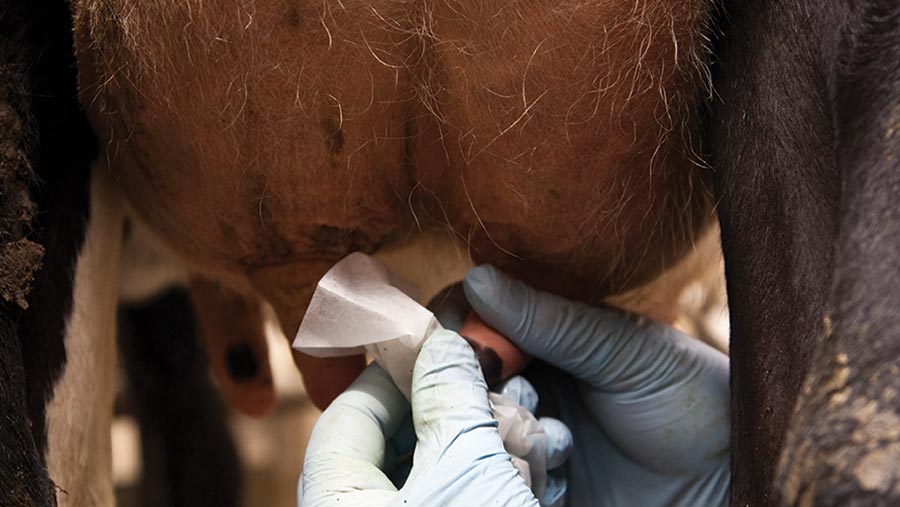Improvements in fertility management bring better yields
 © Anthea Kitching
© Anthea Kitching Increasing the proportion of cows served by 80 days post-calving and getting more cows in-calf by 100 days has contributed to a reduction in calving interval across National Milk Record (NMR)-recorded herds.
The findings are according to the results of the University of Reading’s annual key performance indicator report.
The report for the year ending August 2015 also shows positive trends in somatic cell counts (SCC), with 60% of herds now boasting an annual average cell count of fewer than 200,00 cells/ml.
It compares 32 health, fertility and production parameters from a cross-section of 500 black-and-white herds recorded with at least two years of full NMR records. Results show:
- Cows served by 80 days post-calving has increased from 46% in 2010 to 57% in 2015
- The percentage of cows pregnant by 100 days has increased from 26% to 32% since 2010
- Calving interval has been reduced from 424 days to 410 days.
Report author James Hanks says the fertility improvements are largely a reflection of improvements in heat detection, adding: “While conception rate has remained almost unchanged, producers are serving cows earlier. Heat detection, measured by the percent of interservice intervals equate to one oestrus cycle, has also improved. This means that cows that do not hold to first service are getting more chances to conceive.”
See also: Heat collars improve farms’ submission rates
“This also explains much of the 14-day reduction in median calving interval. One in four herds now achieves a calving interval of 396 days or less,” he adds.
Yield improvements
Improved health and fertility parameters have also contributed to an increased median 305-day milk yield for the year ending August 2015 of 7,905kg, an increase of 505kg since 2010. “The average yield achieved by 25% of herds is 8,813kg,” adds Dr Hanks.
“Particularly important, in view of its impact on herd efficiency, is the improvement in lifetime daily yield with an increase in the median from 10.5kg/day in 2010 to 11.9kg/day in 2015. The target, set by the top 25% of herds, is 13.9kg/day.
“Improvements in lifetime daily yields are the result of better health, fertility and production across the herd and producers should be encouraged by these trends.
“The target, achieved by the top 25% for each parameter, provides realistic and achievable goals for the industry. Producers can use this information to see where the strengths and weaknesses are in their own herds and identify the best opportunities for improvements that will help to improve their efficiency in a cost-effective way.”
SCC
SCC parameters show similar positive trends, and results from a separate analysis of NMR’s 75m milk samples, taken between 2005 and 2015, show:
- There has been a reduction in the numbers of chronic high cell count cows – those with counts above 200,000/ml
- In 2007 milk samples below 200,000/ml accounted for 73% of the total. This has increased to 80% in 2015
- With similar large number of cows involved, this is equivalent to 36,000 more cows recorded monthly with low SCCs in 2015 compared with 2007
- Average SCCs are now 189,000/ml and for the past three years have been below 200,000/ml
Dr Hanks says the improvement in the percentage of milk samples with SCCs below 200,000/ml is “very encouraging”.
See also: Improving dry cow condition boosts milk yield and cow fertility
“This is very encouraging as the chronic cows are the reservoir of infection and their number is strongly correlated to the overall herd cell count. Our 500 herd study in 2015 shows the number of herds where chronic cows make up more than 15% of the cows milked, has nearly halved from 41% of herds in 2010 to 21% of herds in 2015. This has to be the consequence of better herd health management.”
He points out the data clearly shows those herds that keep on top of the level of chronic cows also have a low herd SCC.

“Nine out of 10 herds with below 10% chronic cows have a herd SCC that will normally avoid price penalties, so typically an average below 200,000/ml.
But nine out of 10 herds with more than 15% chronic cows will attract price penalties with an average SCC above 200,000/ml.

“So if the chronic cows are not identified and managed to an acceptable level then the chances are that the herd’s average SCC will be very high,” he adds.
“Using individual cow SCC records carefully and improving herd health has very direct benefits for producers.”
